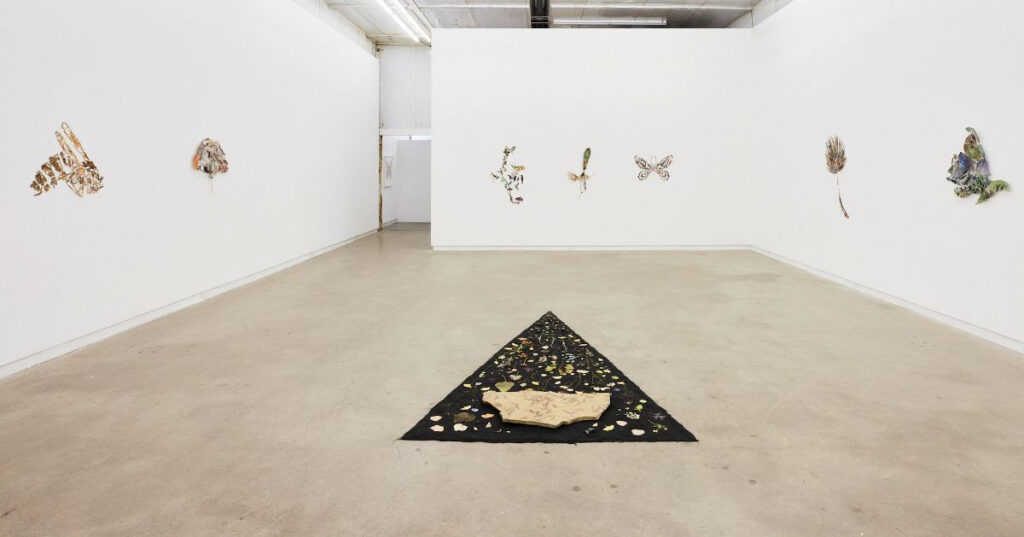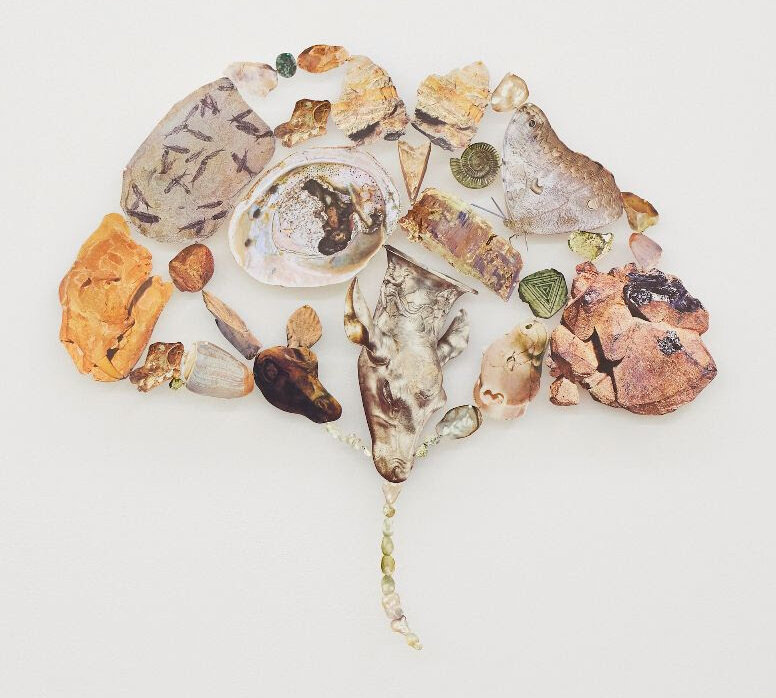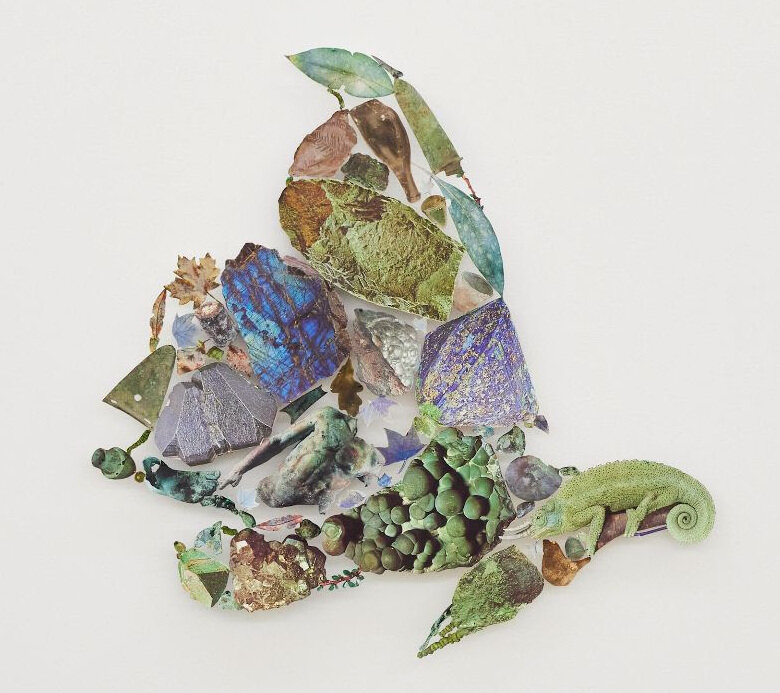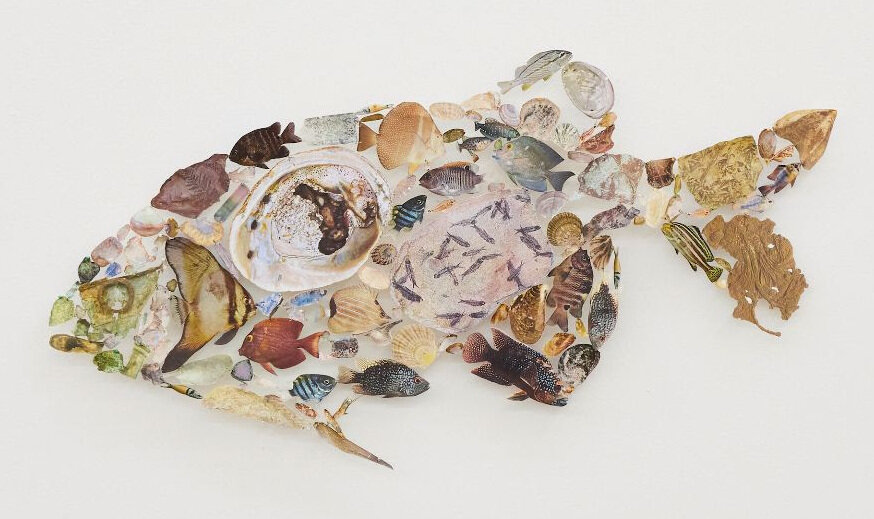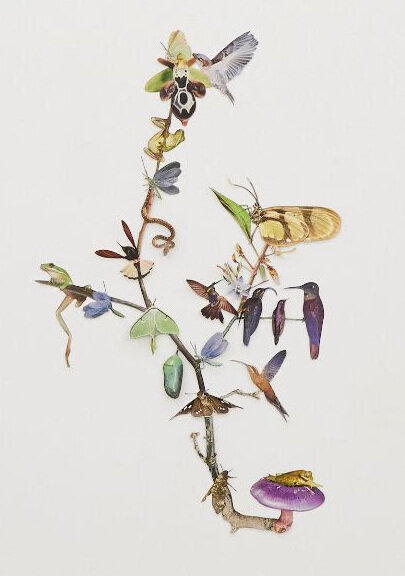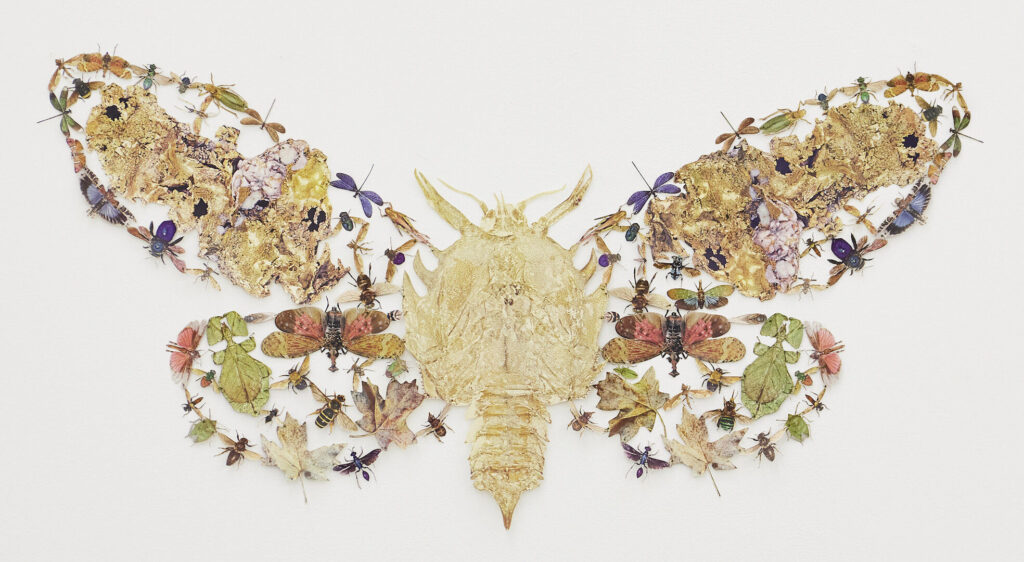At first sight Murphy’s collages seem ready to fall apart. Indeed, their delicate pieces are held together by a fine thread or pins. The pieces are comprised of images of various organisms – both specimens of living creatures and plants, and fossils of those long since extinct – carefully cut out from books and magazines. These patchworks of images of animals, plants and fossils together constitute a larger image of either an insect, a bird, a fish or a plant, in the case of this latest show at Clint Roenisch Gallery.
Installation view of Jennifer Murphy, Elegy for the Golden Toad
The more delicate compositions are suspended directly onto the wall, while some of the more solid ones float a few inches from the wall, casting evocative shadows. They are hard to categorize, being halfway between collages and mobile sculptures. Perhaps they might best be described as ‘paper mosaics’ – a term originally used by eighteenth century artist Mary Delany. (Delany produced hundreds of exquisite images of plants that consist of layers of finely cut coloured paper on dark backgrounds.) This difficulty of categorization points to something interesting about her work, namely that it sits at the margins of what one might call mainstream art.
Jennifer Murphy, Gingko, 2022, collage, 69 x 76 cm (27 x 30 inches)
Of course, given the enormous variety of art produced today, to call anything ‘mainstream’ seems almost futile. But it is exceptions such as Murphy’s, I think, that demonstrate how it is not an entirely useless term. Most artists who use traditional media, including drawing, painting and collages, are to varying degrees concerned with the aesthetic and formal qualities of their images, as circumscribed by the idiosyncrasies of their chosen medium. By contrast, the medium Murphy chooses has limited possibilities with respect to these qualities. One might put it this way: If you or I chose to paint an image, it is highly likely that we will produce very different images. On the other hand, if we both produced images using the methods employed by Murphy, probably our images would be somewhat similar. That is not to deny the inventiveness of her method. Rather, it is to point out that her approach to art is less about those qualities that concern art traditionally. That in itself is not problematic, of course.
Jennifer Murphy, Royal Moth, 2022, Collage, 76 x 76 cm (30 x 30 inches)
What does interest Murphy most clearly is her subject matter. For almost her entire career, which spans two decades, her focus has been on nature. Concomitant with this focus, Murphy tells me, has had an abiding interest in ‘collage’, that goes back at least to her formative years at art school at Queens University. It seems, then, that her approach has been deeply informed by her interest in nature. This fact suggests that Murphy is a fascinating hybrid of artist and naturalist. By the latter term I mean a person who assiduously observes the living world outside the framework of scientific theory and research. In other words, she is not simply an artist who likes to render nature – animals, trees etc. – but an artist whose love of nature is so strong that it shapes her very approach to art.
Jennifer Murphy, Fish, 2022, Collage, 69 x 92cms (27 x 36 inches)
One way her love of nature is expressed is through collecting – flowers, plants, fossils and so on. Her studio houses a collection of these objects as well as a collection of books, magazines or pages thereof, which feature images of nature. It is these things which are the sources for her works, their building blocks. The images she selects for each new work is surprising. Her rendering of an orchid, for example, is comprised of images of snakes, birds, frogs, butterflies, moths, beetles, mushrooms and more! This eclectic and playful selection of constituent images gives the works a surrealist edge.
Jennifer Murphy, Orchid, 2021, Collage, 145 x 65 cm (58 x 26 inches)
In other ways, her work reads like a random cataloguing of their natural world. It is as if by such seemingly random selections of creatures and plants, she is telling us that the living world is interconnected both across species and time – and in unexpected ways. Indeed, she points to coincidences in nature. For example, in her press release it is remarked that she “noticed in the Spring of 2021 that the emergence of the Brood X cicadas after their 17 year cycle of dormancy came to echo a past emergence of the same brood in 1919 during the last pandemic.” And like her works themselves, she sees the living world as terribly fragile. Fossils are seen as reminders of creatures that once crawled across the world, just as we currently do. This awareness only adds urgency to the present ecological catastrophe, namely the current mass extinction caused by us.
Jennifer Murphy, Cicada, Collage, 2022, 114 x 71 cm (45 x 28 inches)
Finally, I find it difficult to pick out particular works on display, because, despite the obvious differences between them, they are in many respects ironically indistinguishable. One might, perhaps, think of each work as part of a larger piece, just as they are each made up of smaller images. But also this indistinguishability reflects a certain obsessiveness to her work. It is as if she is compelled to repeat herself, or rather to keep on pushing the same idea. This trait, perhaps, is also evident in the consistency of her work across the years. Maybe this shows how ardent her love of nature is. Certainly, there is a tenderness and joy to her work that is infectious.
Hugh Alcock
Images are courtesy of Clint Roenisch Gallery
*Exhibition information: Jennifer Murphy, Elegy for the Golden Toad, October 22 – November 26, 2022, Clint Roenisch Gallery, 190 St Helens Ave, Toronto. Gallery hours: Wed – Sat 12 – 5 pm.

